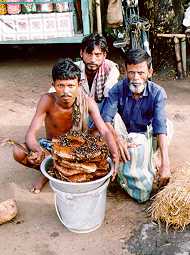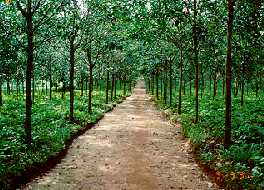Photo Essay from South Asia (4)
Communist Party of India (Marxist) and Rubber Trees:
-- Trip to Tripura, India --
Takashi Kurosaki
Last Revised August 27, 2001 (Japanese version: November 4, 1997)
In September 1997, I visited one of the North-Eastern States of India, Tripura, which is known with its communist governments and tropical agriculture. Tripura is a very small state surrounded by Bangladesh with population of 2.7 million (1991). It was a princely state ruled by a Maharaja before India's independence in 1947. Before my visit, I learned that the state has several unique characteristics --- it received a number of refugees from East Pakistan or Bangladesh, educational achievement is much higher than Indian average, and communist influence is strong with its current government run by Left Front led by the Communist Party of India (Marxist) [CPI-M].
 I arrived at Agartala Airport only after 50 minutes from Calcutta. "Is this a capital city of an Indian State?" That was my first impression. The town was very small and everything was rural. Another surprise was the faces of people. I expected more tribal faces but I found that the majority are Bengalis. On the way to the hotel, I saw paddy fields, tea gardens, and jute fields. "Yes, this is a part of Bengal, indeed," I told myself.
I arrived at Agartala Airport only after 50 minutes from Calcutta. "Is this a capital city of an Indian State?" That was my first impression. The town was very small and everything was rural. Another surprise was the faces of people. I expected more tribal faces but I found that the majority are Bengalis. On the way to the hotel, I saw paddy fields, tea gardens, and jute fields. "Yes, this is a part of Bengal, indeed," I told myself.
This photo (left) shows a honey seller who did his business near a small open market close to my hotel. His product smells of the tribal culture in Tripura but all I found afterwards from government officers confirmed my initial surprise. The ratio of tribal population in Tripura is only 31%. Since the majority 69% of the state population are Bengalis and they are concentrated in small towns, it was no wonder that I felt that Agartala is like a part of Bengal.
Tribal people in Tripura were historically dependent on shifting cultivation ("slash-and-burn" agriculture) but now they are in transition to settled agriculture. The Left Front Government encourages cultivation of natural rubber since they are more acceptable to the tribal culture of these people. Natural rubber forests I visited seemed to me as an "environmentally-friendly" development after I visited barren land with too much shifting cultivation. The counterpart of my visit to Tripura worked for Agartala Station of the Rubber Board of India.
 He took me to a rubber forest nicely managed by the Rubber Board, shown in this photo. Tribal people are employed as workers in this forest and will obtain ownership of several trees after several years of work. This is an excellent system to train these people. An example of such tribal worker is shown in the photo below (left).
He took me to a rubber forest nicely managed by the Rubber Board, shown in this photo. Tribal people are employed as workers in this forest and will obtain ownership of several trees after several years of work. This is an excellent system to train these people. An example of such tribal worker is shown in the photo below (left).
 The main research station of the Rubber Board is in Kottayam, Kerala. Kerala is an Indian State in the South, also famous for her communist tradition. Many professionals working in Agartala Rubber Board are based on Kottayam Station. Because of education and food problems, the majority of them prefer to come without their family.
The main research station of the Rubber Board is in Kottayam, Kerala. Kerala is an Indian State in the South, also famous for her communist tradition. Many professionals working in Agartala Rubber Board are based on Kottayam Station. Because of education and food problems, the majority of them prefer to come without their family.
My counterpart was an exception to this rule because he belonged to a Tripura tribe. He worked as an extension worker in the Rubber Board in Agartala. In some sense, the future of his village located 150km from Agartala depends on the success of the Rubber Board in innovating and transferring rubber technology. Because of this reason, he worked much harder than other staff members who come from all parts of India including Kerala. The Left Front Government of Tripura is supported by persons like him. Tripura is linked not only with West Bengal, another powerful base for CPI-M, but also with Kerala. Although the two states are geographically far apart with a distance of thousands of kilometers, they are linked strongly with rubber plantation and CPI-M.
Currently, the access to Tripura is very bad. Bangladesh border is within a walking distance from Agartala town. Bangladesh railway runs also close to the border. A metropolitan city of Dacca and an international port city of Chittagong of Bangladesh are very near. But Tripura people cannot utilize its neighbors for transportation. Trade through this route is not open. Consumption commodities to Tripura come via Assam and export commodities of tea and jute from Tripura go via Assam. With this disadvantage in transportation, development perspective for Tripura is not high. My counterpart told me, "In Agartala, even Rickshaw pullers cannot go to Calcutta without buying air flight tickets!"
Back to Mariamma's Homepage (Information on South Asia): HOME; English Index
Back to Tak's University Homepage
 I arrived at Agartala Airport only after 50 minutes from Calcutta. "Is this a capital city of an Indian State?" That was my first impression. The town was very small and everything was rural. Another surprise was the faces of people. I expected more tribal faces but I found that the majority are Bengalis. On the way to the hotel, I saw paddy fields, tea gardens, and jute fields. "Yes, this is a part of Bengal, indeed," I told myself.
I arrived at Agartala Airport only after 50 minutes from Calcutta. "Is this a capital city of an Indian State?" That was my first impression. The town was very small and everything was rural. Another surprise was the faces of people. I expected more tribal faces but I found that the majority are Bengalis. On the way to the hotel, I saw paddy fields, tea gardens, and jute fields. "Yes, this is a part of Bengal, indeed," I told myself. He took me to a rubber forest nicely managed by the Rubber Board, shown in this photo. Tribal people are employed as workers in this forest and will obtain ownership of several trees after several years of work. This is an excellent system to train these people. An example of such tribal worker is shown in the photo below (left).
He took me to a rubber forest nicely managed by the Rubber Board, shown in this photo. Tribal people are employed as workers in this forest and will obtain ownership of several trees after several years of work. This is an excellent system to train these people. An example of such tribal worker is shown in the photo below (left). The main research station of the Rubber Board is in Kottayam, Kerala. Kerala is an Indian State in the South, also famous for her communist tradition. Many professionals working in Agartala Rubber Board are based on Kottayam Station. Because of education and food problems, the majority of them prefer to come without their family.
The main research station of the Rubber Board is in Kottayam, Kerala. Kerala is an Indian State in the South, also famous for her communist tradition. Many professionals working in Agartala Rubber Board are based on Kottayam Station. Because of education and food problems, the majority of them prefer to come without their family.